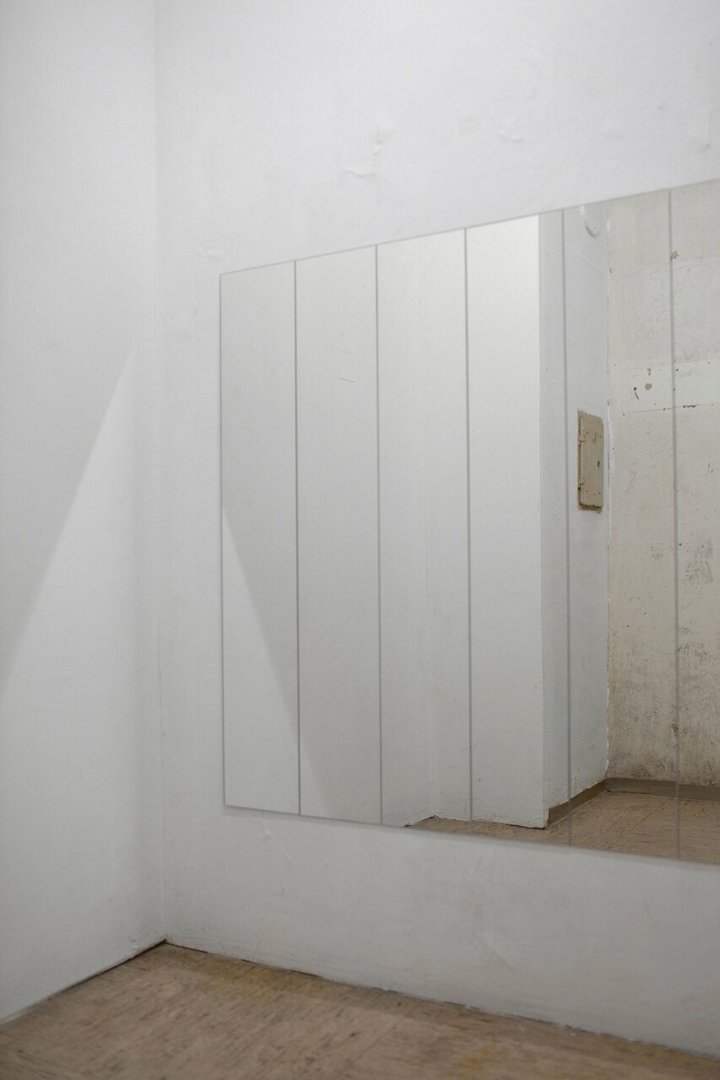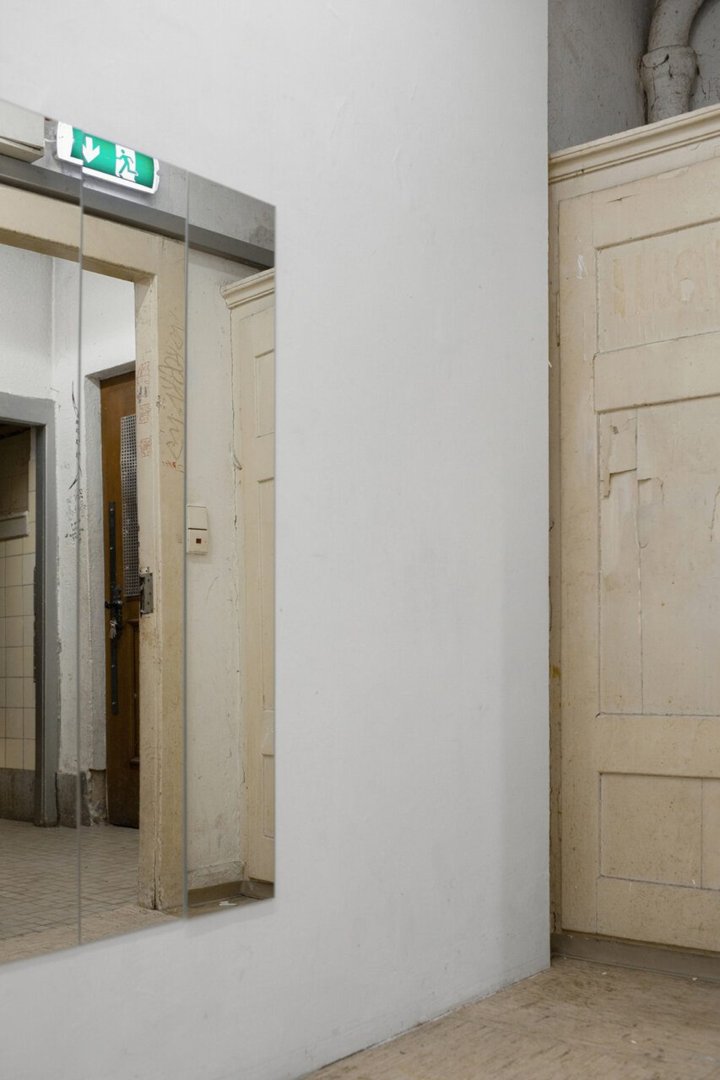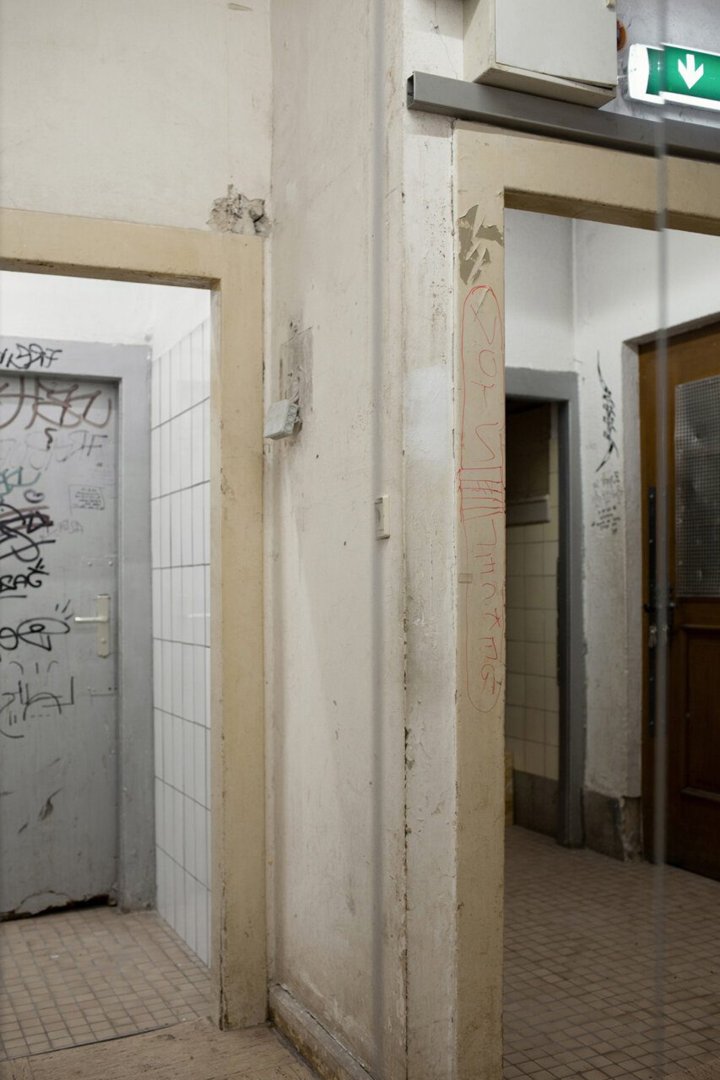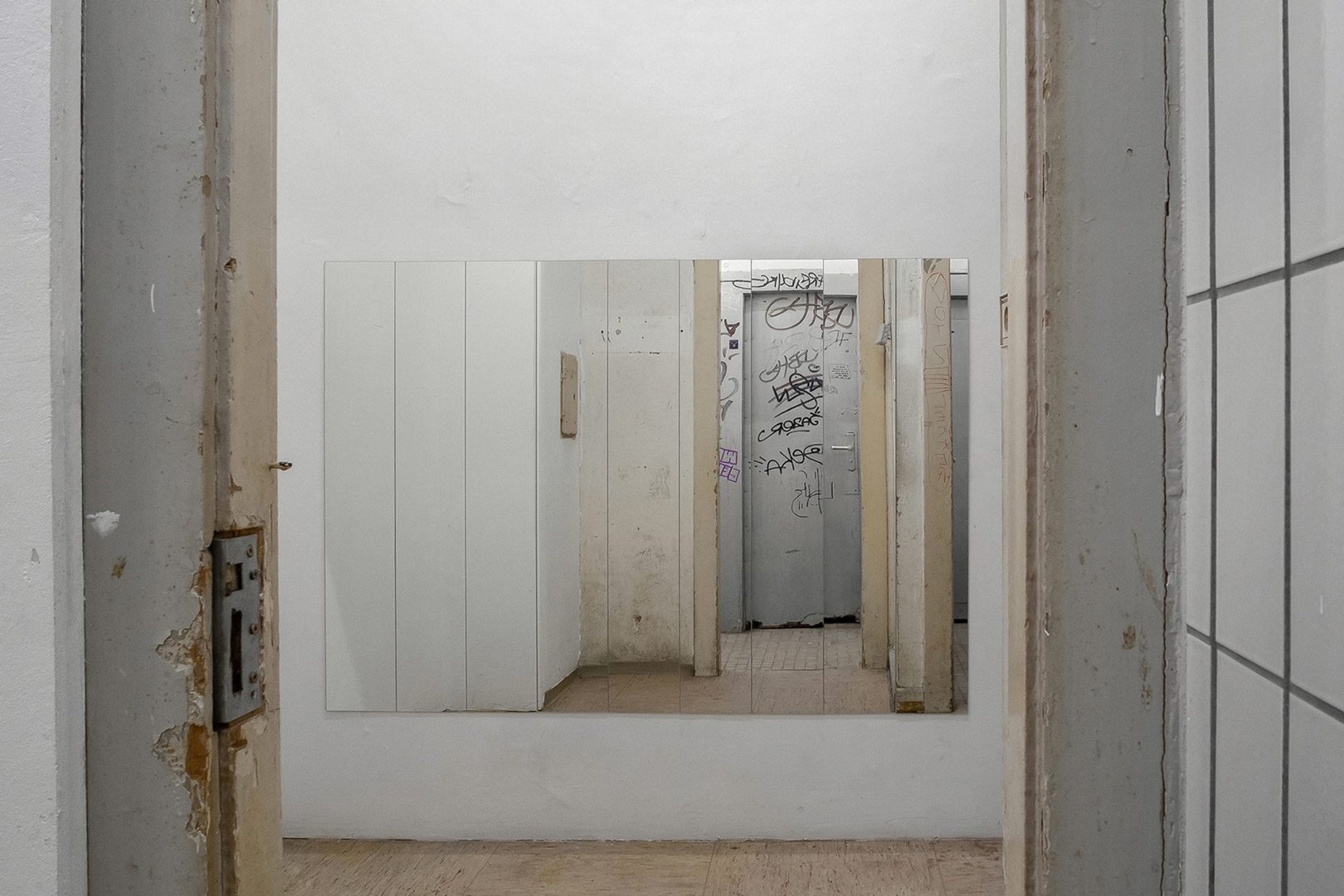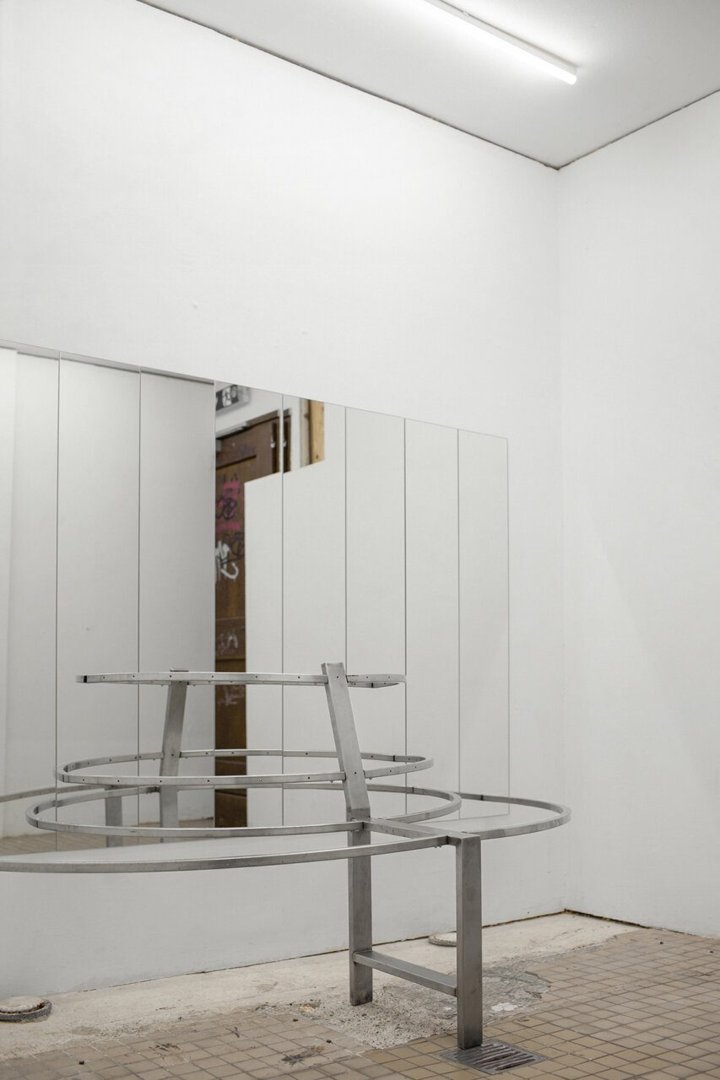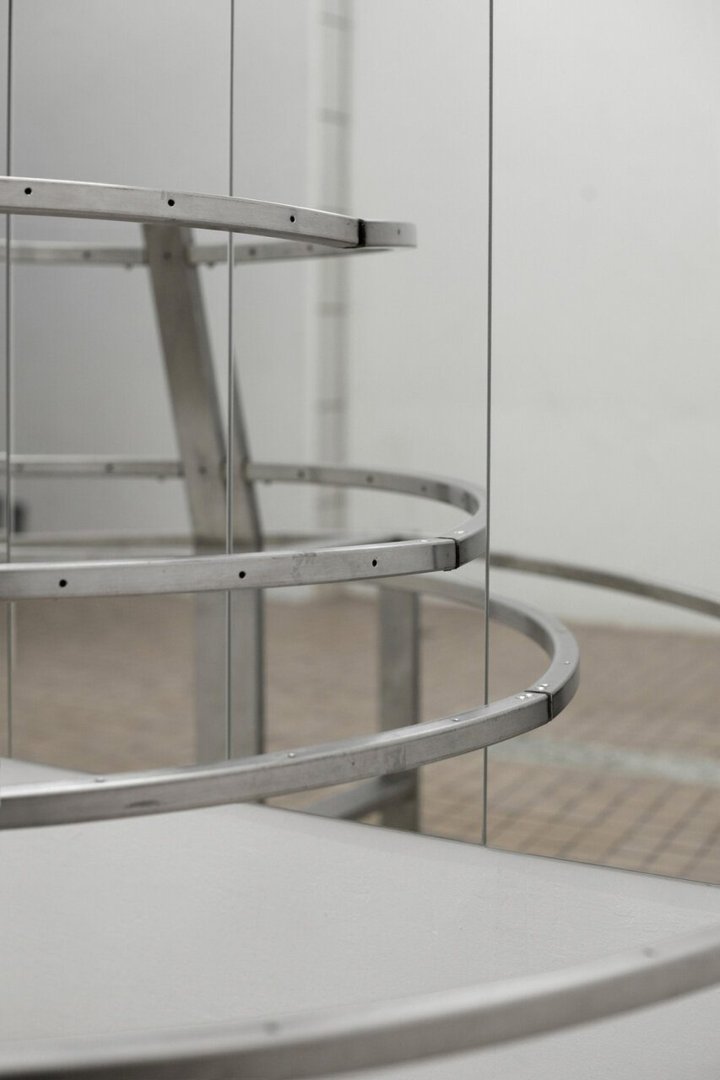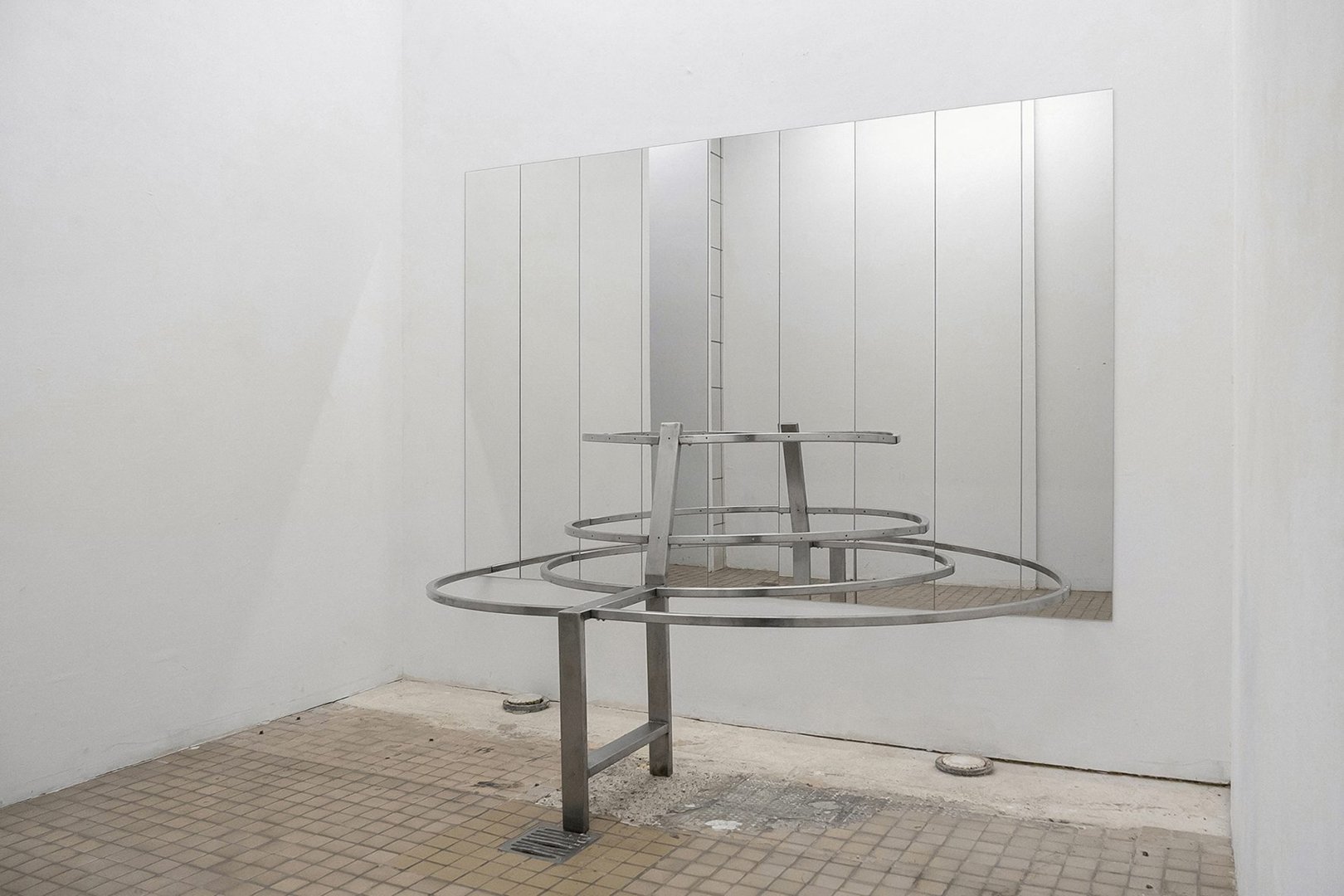Between public and non-public art lies a chasm of experiences which both contradict the fallacy that art is an inherently erudite confrontation and confirm the need for pre-existing knowledge in order to pose as a formal analyst.
A public space suggests a people’s place, a house of commons, whereas the private domain is a value determined by levels of exclusion. And whilst it’s tempting to make dichotomic references to accessible or inaccessible, usually one can find a way into both, if not by brute force, then by a little finesse. These rooms we’re standing in, were once the most private of domains; restrooms, opened to the public in 1906, which decades later turned once again a reserved Räume für Ruhe for tête-à-têtes when recreational drug users found respite here, and further privatised when En masse became à deux as a cruising spot. And now perhaps the most private of domains again – a fine arts space – keepings its original guardianship title “Kaiserwache” as an ode characterised by a suspended duration of being; a legend.
Giving this building a new name, would have emptied these rooms of their meaning, hiding the social relations that were invested in them. And modernising past the passé as antidote to the outdated is just another aspect of our general tendency to shout for the dernier cri.
There is a direct correlation between a value of a room and the assumed value assigned to any matter placed in that room. And in these rooms are objects with stories and architectural movements at work which aspire to keep their presence.
Lately I’ve come to realise a deliberately missed opportunity in that, although I don’t receive commissions (or seek them out) to create public art works, public sculpture, my praxis generates an ongoing series of skulptur projekte. But realising that I’ve spent the last two decades discarding works in the street undocumented in its discarded state gives off the same mixed emotions as when I cut off my below the butt, Ophelia-esque hair without doing so in sections. Both gestures of discarding. Both resulting in a new form. But the truth is that if I were to make another artistic act out of the documentation, I would end up with a kind of watered down simulacra of the act itself rather than enact the potency of discarding something. I would be baking myself a kaka på kaka, which is the Swedish saying for a cake atop of another cake, not to be confused by the crème de la crème, but might, the same way we’ve come to misuse decadence as opulence, be lost in the contemporary mis-translation of everything needing to be optimised as production value; Pic or it didn’t happen.
Reflecting the parameters of the eras of publicness in flux within this space, the shifting public-cum-private-cum-pseudo-public, mirrors offer a pictorial space which frames the space itself, rather than add an additional motif. After all, a work of art is not only its content but also the limitations of its milieu. This fluctuating quality of publicness by appointment reflects the current status of the Post-öffentliche raum. In which I place a singular Post-öffentliche objekt.
By removing the social, whereas park bench; a seat for sun seekers, a respite for weary legs and tired bums, where our own body once articulated a corporeal experience in relation to it, this new condition generate the disembodiment of sculpture; an excavated shell or chassis hollowed of purpose implementing the restrictions of the formal. But even though das ready-made ist eine Cremetorte der kunstgeschichte geworden, the material of everyday life can offer a way of understanding mutations of banalities. It can show its hidden social values; Still lives can live, still. And it is not lost on me that my practice generates a kunst-zyklus in its praxis of finding, showing and discarding.
The first section of mirrors offers the space back onto itself as a pictorial sphere, a bild-im-bild, the second section of mirrors opens up an amalgamation between object and room. Moving that which was once a public utility, into the rooms which were once publicly utilised, as a presence of an absence, the former, where the stripped use-value of the thing becomes a material geist of the public gestalt.
-Sanna Helena Berger
_______________________________________
Should I call her “Berger” or “Sanna”? On one hand, I don’t feel like I know her well enough, or perhaps at all, to call her “Sanna.” On the other hand, I suspect that referring to her as “Berger” would bolster this age-old attempt to make the artist—and with them, the work—something cold, distant and untouchable. The various art actors I consulted have offered different explanations for this convention. One point they seem to agree on is that it must, at least in some capacity, be an attempt at objectification. An object can’t talk back and stays still (most of the time), thus one is able to grasp it (intellectually)—the indolent curator’s wet dream. However, I cannot be talking to an object because it’s talking back and beginning to permeate the text. I hear not “Berger” but “Sanna” conversing in the background, tying knots into the fabric of my writing, posing questions, and lingering on art historical references. So, let’s proceed this conversation with “Sanna.” Yet, keep in mind that where “Sanna” is, “Berger” can never be too far behind; the artist and her image.
This intertwining of voices brings to mind an important aspect of writing exhibition texts: the presence of the readers. I don’t know about you, but when I write, I hear the voice of my intended audience. In this regard, an exhibition text becomes like a letter to someone. Many of mine have been addressed directly to the artists. They vary in style and emphasis and may even contradict each other in their postulations. That is what makes a text personal—not the hypocrisy itself, but the measured and adjusted approach, because each artist and their particular work require that we speak differently to them. Writing, to some extent, involves the extra effort of individual accommodation, so in a sense one always writes together with one’s reader(s). This raises the question, dear reader: What accommodations can I provide for you? In other words: Who are you? Who is receiving this letter besides Sanna? As you engage with this text, you reveal your own position, but for now, I will tentatively categorize you as part of what Sanna calls the pseudo-public. The concept of the post-public or pseudo-public seems to pertain more to the nature of its audience than to any specific physical space. The audience creates a particular kind of space. In this respect, public space can still be a clubhouse sometimes. A text also represents a kind of space that can be understood in these regards. When I address you, even the pseudo-public you, we enter a site of negotiation, a bazaar for values, where meaning and value are continually bargained over. I offer you some; you may reciprocate or veer off into smoother terrain. Let it be known, this text will be a rough patch, especially if my assumptions about you turn out to be correct.
During my research on Berger, I was surprised to find out that the majority of her exhibition texts are penned by Sanna. To my knowledge, an artist writing their own exhibition texts is a rarity. Her texts are characterized by this curious voice with an idiosyncratic accent and peculiar mannerisms permeating through all the art speak the artist-writer has entrenched herself in. A hefty cocktail of irony, self-awareness, and reflection imbues her writing with a unique vitality. Admittedly, it’s challenging for me not to be drawn into her linguistic whirlwinds, which incite replication as I write. This is partly what I mean when I say that Sanna is speaking in the background—her voice haunts my typing fingers. Her texts are not merely supplementary to the physical work presented but are rather an integral part of it. I urge you to seek it out for yourself to truly grasp this relationship and the nuances of her diction that my description may not fully capture.
When I follow her winding sentences on the page, sprinkled with hyphenated neologisms, she appears to surrender to the flow of her subjective position, recounting anecdotes, combining expressions and phrases from German and French to form her own poetic language, thereby exploring the untested waters of what art vernacular could potentially be, other than a litmus test for the in-group. Then again, it is something clearly addressed to the in-group, even if out of necessity. Who else, other than curators and art people bored out of their minds, would find time to be surprised by something so niche, something that presupposes extensive insider knowledge?
It is crucial not to dismiss the ubiquitous accusations of elitism and obscurantism often directed at contemporary art. There is definitely something to these claims. It partly stems from the fact that art naturally extends beyond its own boundaries, always being a part of a larger context. This context, our world, is ordered by capital and its highly asymmetrical distribution. As a result, access to contemporary art—particularly in terms of ownership and its accompanying liberties—reflects this economic disparity. Another factor contributing to these barriers of entry is something that Sanna’s writing demonstrates all too well: art intellectualism and the self-referential nature of art fostering insularity. The highly specialized discourse becomes a cover for the rich to continue operating as before undisturbed. This is the powerful alliance between specialist art discourse and wealthy special interest groups! Even with all its attempts to involve a wider public, contemporary art remains generally in the purview of a certain few. Since the art world operates within a tight and narrow economy where various forms of value— be it aesthetic, representational, financial, political, and social—appear to be tethered to, if not directly generated by, the virtue of exclusion, I would argue that the pseudo-public nature of contemporary art, leaning more towards the private than the public, is not merely a flaw but a feature. Art—its appearance, concerns, and the ways we interact with it— needs to be a pseudo-public affair because its very identity and worth are built on controlled access. Scarcity creates a sense of privilege and prestige around art objects and experiences, which in turn fuels their market value and cultural capital.
For this scheme to continue, contemporary art must remain obscure to the general public. The rules of the game are denied to them, keeping art an insider’s domain. As Baudrillard aptly notes, “art has become involved (not only from the financial point of view of the art market, but in the very management of aesthetic values) in the general process of insider trading.”¹ The differentiation between the insider and outsider becomes contemporary art’s constitutive act. Aesthetic judgment, i.e. good taste is regulated by self-legitimizing procedures that stay opaque to the general public. These procedures involve a complex interplay of critical acclaim, academic endorsement, market validation, and institutional recognition. In essence, they create a feedback loop where artists, curators, critics, and collectors (art actors) validate each other’s positions and contributions, thereby reinforcing their collective status and influence within the art world. But whose survival strategy is it—art’s or capital’s?
As a matter of fact, public art funding, ostensibly a democratic endeavor, also falls prey to these dynamics. Funding bodies, cogs in the art machine, influenced by trends and reputations established within this opaque system, often allocate resources to those already recognized within our incestuous art world. Consequently, the cycle of exclusivity is perpetuated, with public funds reinforcing the very hierarchies they are meant to democratize. There is no denying it—Kaiserwache plays into this system, and even this text is complicit. But how, dear reader, can it escape its captivity from the dim echo chamber of art discourse?
If what we experience in Skulptur Projekte is conditioned by this apparatus, its pseudo-willing participants’ responsibility is called into question—especially the critical ones addressing the state of things, who are making art or discourse out of the unsavory. When critique becomes an integral part of one’s work, it becomes intertwined with and reliant upon the very system that is being criticized. In this context, the stability of one’s position within the art world becomes dependent on the persistence of the issues being addressed. Essentially, contentious engagement with the system—while ostensibly a challenge to it—also becomes a component that helps sustain the system itself. The machine keeps running fueled by the ongoing cycle of critique and resistance that both exposes and perpetuates its flaws. Doesn’t engagement with art, no matter how critical and resistant it may be, involve a level of complicity with the existing system? This might encapsulate the core internal conflict within art today.
In any case, Sanna would agree that art is a dirty business. But again that doesn’t stop the victim from becoming a culprit. Although in this entangled system, it becomes pointless to designate these labels. You and I are simultaneously victims and accomplices; in the pseudo-public or post-public domain, we are post-victims and post-perpetrators. Nonetheless, Sanna must play the game, armed to the teeth with criticality, skepticism and self-reflection. It feels like an impasse. But what can you do if you don’t continue in spite of things being the way they are? Jumping ship seems not to be the appropriate response. It’s a complicated situation that doesn’t bring forward simple ethical responses. Hence, Sanna’s work can’t be viewed as a manifestation of a conclusive handling of the situation either. Right, Sanna?
It seems to me that Sanna deliberately sets out to wallow in the dirt of art, only to immediately clean up and observe her indulgence from a distance, all in a single sweep. She examines her clothes, which are somewhat dirty and somewhat clean. In the mud pit before her, she sees not just her reflection but the mirror itself. The secret to this game is that there are no perfect mirrors. You’re always in a fun house where the distortions of your image become tools for concealing your dirt. When I engage with her work I can’t help but have the feeling of being tugged into the wallow as well. Dear reader, now it is time to take a good look in the mirror. Perhaps you have a way out of this conundrum or a better analytical framework that puts the pieces in a more promising constellation. In that case, please contact me.
Sanna’s work is as “conceptual” as it gets. The whole framework, all the ebbs and flows of an art apparatus lend themselves as materials for her sculptures. I don’t think they can simply be analyzed as objects that relate to this or that self-referential art thing. The works are mobile, they are continuing to shapeshift along with a broader network of current art discourse and its inevitable mutations. The potential of Skulptur Projekte hinges on a transformation of the outside that has immediate effects on the inside. I believe her work (and that of many of her artistic peers) merits revisiting in the near future. Who will we see in the reflection in a few years. When the deck is reshuffled and the cards are dealt anew, sometimes the rules of the game change. Fun houses are usually mobile constructions, which can be dismantled for transport.
The past, once the present, is shaped by multiple futures (there is no singular future), reflecting a malleable cohesion of principles. We receive signals from the stars ahead, making time travel a regular occurrence. Heroes become villains, public commons become private (the inverse happens to a lesser extent if at all), mirrors turn into mirages and so on. In this sense, it is perhaps too early to say definitively what we are looking at. In a more abstract way, we’re certainly gazing at ourselves but we can’t yet say who we will be. Our reflection moves. In the mirrors that make up Raumwiderpiegelung and Post-öffentliche Objekt, we catch glimpses of ourselves. We gaze at you and me and all the legitimating processes that make us believe it is us who we see. But we’re not we, dear reader. Amidst us there is a divide. Some artworks are like jokes, dependent on a certain immediacy of humor and the witness’s ability to connect the dots on the fly. Explaining the necessary elements of the joke might provide insight into its structure, but you’ll never recapture the singular moment of recognition, the point of contact, that impulse of captivation. Dear reader, did you get the joke?
¹ Jean Baudrillard. The Conspiracy of Art, 2005, Semiotext(e), page 29
-Ilja Zaharov
_______________________________________
Once upon a time—in 1975 to be exact—in a quiet charming town named Münster, a curious visitor named George Rickey arrived by the request of the town’s art commission. With him, he carried an unusual contraption: three metal squares mounted on a pole, twirling in the air like a whirligig. It was a sight unlike anything the townspeople had seen before—a modern formalist sculpture in fact, abstract and seemingly incomprehensible.
In the heart of the enchanted town, where the art commission was revered as the noble keepers of the town’s cherished aesthetic traditions of figuration, a great decision was made. Unbeknownst to the townspeople, the commision called upon the renowned Rickey, a wizard of modern artistry in the bustling cities far beyond the town’s borders. “Münster too can shine like those grand cities!” they proclaimed with hopeful hearts. “We must summon Rickey!” they cried out.
But when Rickey’s peculiar creation was unveiled, the townspeople were bewildered. The sculpture’s avant-garde nature left them puzzled and uneasy. They wondered if such a thing belonged in their beloved public park. Letters flooded the local press, where residents passionately debated the artistic merit of the sculpture. The mood in the town grew heated as the debate raged on, and soon the citizens, driven by their bewilderment and displeasure, began to offer a wide variety of counter-proposals. Despite the protests, Rickey’s creation was destined to find its place in the city for good.
Enter the director of the North Rhine-Westphalian Art Museum, a man of great vision and a morbid sense of humor. He saw the townsfolk’s resistance not as a barrier but as an opportunity to teach them about good art. “If they do not appreciate art,” he declared, “then let us immerse them in it! Let us give them double and triple of what they don’t want!” Gathering a troupe of artists, he devised a grand scheme: an art festival unlike any other, to be held every decade, transforming Münster into a living, breathing exhibition space.
Thus was born the Skulptur Projekte, a festival to showcase monumental sculptures in public spaces all around the town. At the premiere exhibition in 1977, the whimsical artist Claes Oldenburg contributed an aptly titled piece, Giant Pool Balls. These enormous spheres, boring and playful at once, were placed at the serene banks of Aasee. However, the disgruntled townspeople, still simmering with resentment towards the contemporary art invasion, took matters into their own hands. With a collective heave, they rolled the giant balls into the lake, creating a splash heard all around the town.
Undeterred, the art commission, with a quiet determination, reinstalled the giant balls, letting the public’s initial fury wash over like waves on the shore. They knew that time had a way of softening even the most hardened hearts. And indeed, as the days turned into weeks, the weeks into months, the townspeople adapted to the good taste ordered from above.
The giant pool balls, once a symbol of their defiance, became a curious landmark, a point of conversation, and eventually, a cherished part of their landscape. Each decade, as more and more artworks were introduced, Münster transformed into an ever-expanding open-air gallery.
And so, the townspeople of Münster lived happily ever after, surrounded by sculptures they neither chose nor fully understood but still had to pay for. They may have accepted the art, but whether they ever truly accepted the good taste—or simply resigned themselves to it—remains a question as abstract as Rickey’s twirling squares.
-Ilja Zaharov
_______________________________________
About the Artist:
Berger has previously exhibited at Centralbanken (Oslo, 2024); Rinde am Rhein (Düsseldorf, 2024); PHILIPPZOLLINGER (Zürich, 2024); Cittipunkt (Berlin, 2024); Shahin Zarinbal (Berlin, 2023); Den Frie (Copenhagen, 2023); Baerum Kunsthall (Oslo, 2023); Galerija Miroslav Kraljevi? (Zagreb, 2023); Waf Galerie (Vienna, 2023); Skånes Konstförening (Malmö, 2023); Kunsthalle Bremerhaven (2022); Spazio ORR (Brescia, 2022); Kunstverein Kärnten, (Austria, 2021), Cell Project Space (London, 2020) and more. Berger’s texts have been published by Velag Ida Neustadt, vorstellen.network, Jennifee-See Alternate, Artist Network Theory, Eva Hesse Foundation and Las Injurias. She is a co-founder of the performance programme ‘amatter’.
About Kaiserwache:
The former public restroom, known to Freiburg residents as „Kaiserwache,“ was well-frequented due to its central location in the city and proximity to the banks of the Dreisam. However, with its original purpose decommissioned, the question of finding an alternative use for the heritage-protected building has arisen. This question has become increasingly relevant, especially given the growing lack of space in Freiburg, despite many buildings remaining vacant. With this in mind, KW positions itself as an offspace that is concerned with its own temporality, interested in suggesting alternatives beyond its interim use. The space at KW acts as a catalyst for the presentation of site-specific works and the facilitation of discourse surrounding the institution of the public toilet. By showcasing site-specific works, KW offers a unique platform for artists to reflect on and engage with the space‘s heritage and temporality.
Curated by Christina Sperling, Lena Reckord and Ilja Zaharov.
This exhibition was made possible with the support of the the Swedish Arts Council, the Cultural Office of Freiburg and the Regional Council of Freiburg.



